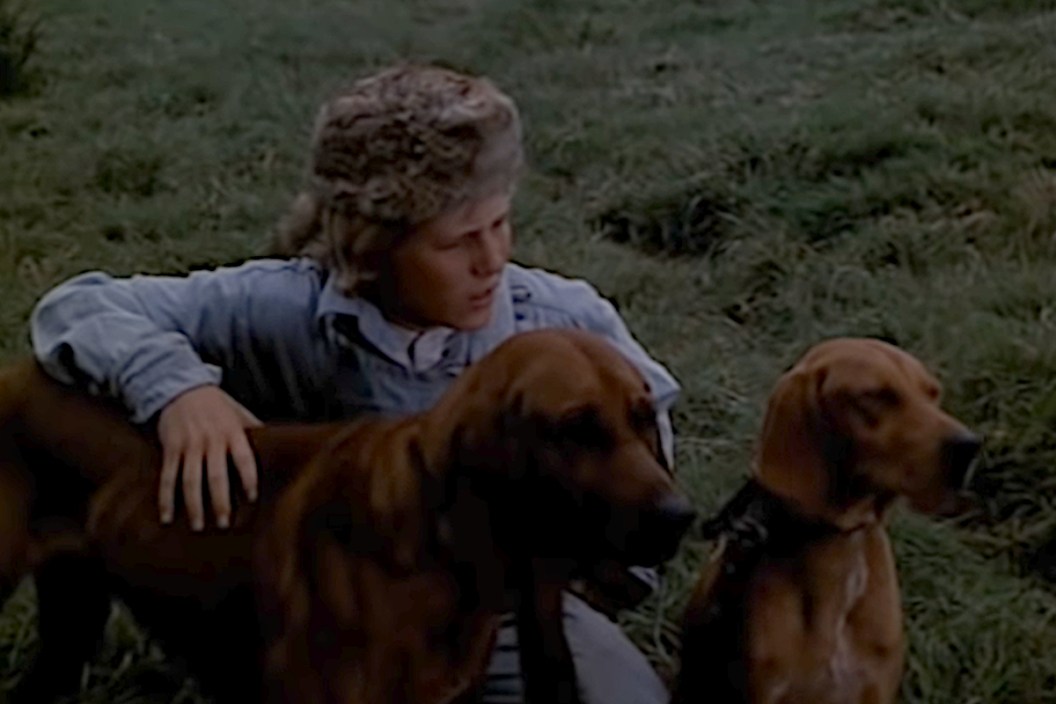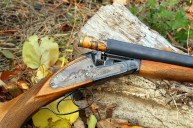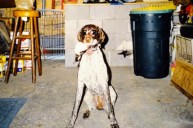Where the Red Fern Grows is a hunting classic.
If you ask a group of outdoorsmen and women about some of the best books and movies about hunting that have ever been made, "Where the Red Fern Grows" is bound to be in the discussion somewhere. This classic coming-of-age story set in depression era Cherokee County, Oklahoma is considered by many to be the best stories about hunting dogs ever conceived.
Today we'll talk a little about author Wilson Rawls, where the inspiration for this timeless storyline about raccoon hunting and more importantly, the bond between a young boy and his redbone hound dogs.
This is the story of "Where the Red Fern Grows," and the legacy this hunting story leaves behind.
Where the Red Fern Grows, the Author
Like many successful authors, Wilson Rawls found success in writing about what he knew best. He was born in the hills of the Ozarks, in Scraper, Oklahoma in 1913. The parallels between Rawls' real life and his famous protagonist Billy Colman are unmistakable. Rawls' grandparents owned a store. His family were farmers and were dirt poor. As you might expect, growing up in the Ozark Mountains, Rawls' primary interests were like that of many boys growing up in the area, hunting and fishing. Because the area was so remote, his primary friend was a dog.
Rawls and his five siblings received most of their education from their mother. The rest of his education was in a tiny, one-room schoolhouse where the other mothers rotated through as teachers. Even though he learned to read and write, his skills at both were not great by his own admission. In fact, he didn't have much interest in books until his mother got a copy of "Call of the Wild" and read it to her children. For the young Rawls, Jack London's classic adventure novel about a man and a dog was a revelation and an inspiration.
"When she started reading that story, I was never so fascinated by anything in my life," Rawls said later in a speech.
He later said he re-read the story so many times that he eventually wore his copy out. From then on, he was determined to write a similar tale involving dogs. He was encouraged by his father, who Rawls later recalled told him:
"I believe a man can do anything in life that he wants to do, if he really wants to do it," Rawls later recalled. "And once he starts reaching out for it, never give up."
Those wise words ended up resonating with the author for the rest of his life.
Where the Red Fern Grows, the Book
Rawls eventually left home in the middle of the Great Depression, and ended up travelling all over the country looking for work. When he wasn't working, he was using every spare moment to write. The young man would scavenge pieces of paper from the garbage to write his stories. However, he was ashamed of his writing skills and refused to let anyone see them, storing them away at his family's home whenever he stopped to visit.
It was during this time that he first came up with the story that would eventually become "Where the Red Fern Grows." Rawls stashed the story away and then spent many years working in oilfields and as a carpenter. Eventually his travels led him to Idaho where he met and married his wife Sophie.
Believing his writer dreams had caused him nothing but misery to that point, it was around this time that Rawls burned all his manuscripts, including what would eventually become Where the Red Fern Grows. The world may have never known this story had Rawls not eventually told Sophie about it. Intrigued, she encouraged him to re-write the book from memory. Fortunately, Rawls said he had the story "memorized" and he was able to re-write his novel long hand in about three weeks.
He was understandably nervous and worried about having someone read his work for the first time, so when the first draft of the book set in Cherokee Country was finally finished, Rawls went into town all day while Sophie became the first person to read the story about Billy, Old Dan and Little Ann. To Rawls' amazement, she loved it. However, she also recognized that it needed to be longer to qualify as a novel. The first draft of the book was only about 30,000 words. Rawls responded by writing a second draft of about 80,000 words. Sophie edited and typed up the hand-written work before sending it to the Saturday Evening Post, who first published the story in 1961. The first publication of the novel was in three parts under Rawls' original title, "The Hounds of Youth."
When the manuscript went to Double Day publishing for book format, Rawls said the company's editors "broke his heart" when they changed the title to Where the Red Fern Grows without telling him. However, there was nothing he could do at this point. The book first went to print in 1961. The only problem was sales. They were slow because publishers mistakenly marketed it as a book for adults rather than a children's novel as Rawls had originally intended. It took several years, but eventually teachers started recognizing the story's value in education and sales took off. The rest was history.
Film Adaptations
The story about a boy's love for coon hunting and his dogs was first brought to the big screen in 1974. For the production, the filmmakers shot the film on location in Oklahoma. Rawls was present on set, he noted later that it was the first time he'd been back to the Ozarks since he left as a boy. Rawls said the production of the film "transported" him back to his childhood. He's also the narrator you hear throughout the movie, which was a nice touch. The film cast Stewart Petersen in the role of Billy, Jack Ging as his father, Beverly Garland as his mother and James Whitmore has his grandfather.
The film does differ from the novel in many aspects. It cuts out the opening scene of the novel where an older Billy finds a redbone coonhound under attack from neighborhood dogs, triggering the flashback to his coon hunting exploits as a boy. Other scenes, such as Billy's attempts to trap a coon to acquire a pelt to train his dogs, were also cut. However, for the most part, the film is faithful to a story that is both heartwarming and heartbreaking. From Billy's struggles to earn enough money to buy two very expensive dogs in the middle of the Great Depression, the iconic chopping down of the Sycamore tree, to the unfortunate accident that kills Rubin while trailing the "Ghost Coon," and the way Dan and Ann save Billy's grandfather during the championship coon hunt, little was changed about the story.
The film has gotten mostly positive reviews over the years for being faithful to the source material and currently holds a 6.9/10 on IMDB.com. For many hunters who love dogs, this is one of the best hunting movies ever made. Copies of the film can be hard to locate, but it's available to stream for free on Amazon Prime video. I also found the full film on YouTube for those without a subscription.
In 1992, a sequel was made. Rawls had nothing to do with this production since he passed away at the age of 71 in 1984. The new movie starred Doug McKeon as a much older Billy Coleman, who returns home from World War II minus one leg and suffering from severe PTSD. Grandpa was recast as Wilford Brimley. He buys Billy two redbone hounds to help him heal from the war. Reviews seem to be mixed on the sequel. One of the dogs again dies in this film, and Billy leaves his surviving dog in the care of a young boy before moving to California for work at the film's conclusion.
A remake of the original film was shot in 1999 and released in 2003 with Joseph Ashton as Billy, Dave Matthews as his father, Renee Faia as his mother, and Davney Coleman as grandpa. This film was shot in the same locations as the original. It is a nearly a shot-for-shot and line-for-line remake of the original from the introduction of the family to the mountain lion attack. There are some differences. The opening scene from the novel is included in this one. The Ghost Coon scene is slightly different. Instead of Billy tripping Rubin and causing him to fall on the axe, Rubin simply trips and falls on it on his own. This version also contains a few more montage sequences and songs than the original. It's not a terrible film, but we're also not sure why someone felt the film had to be remade. It does enjoy a generous 6.4/10 rating on IMDB. Make of that what you will.
The story's legacy.
Unfortunately, Rawls only wrote one other book during his career called Summer of the Monkeys. The fact that he only has two novels has left many wondering what his career would have been had his talents been discovered earlier. When he burned the original draft of the story, he said he burned as many as five novels and dozens of short stories. What those stories may have been about is anyone's guess. It seems we will never know. However, it's worth noting that Rawls said his one and only regret about his writing career was that his father did not live to see his works published.
In 1999, Idaho Falls, Idaho commemorated Rawls' life and legacy by unveiling a life-sized statue of Billy, Dan and Ann made of bronze in front of the Idaho Falls Public Library. Titled "Dreams can Come True," the statue continues to draw fans of the novel there to this day. Additionally, every year, Tahlequah, Oklahoma now holds a "Red Fern Festival" to celebrate the book and film. In addition to screenings of the films, the event hosts many events for the whole family. Yes, that includes a traditional coon hunt with dogs.
Where the Red Fern Grows has already cemented its place in literature and the movie continues to be a fixture at hunting camps across the country. Really, we should feel fortunate that a story about hunting continues to resonate with young audiences in a day and age where interest in hunting seems to be waning. Hopefully, it will continue to inspire new generations of young people to venture into the woods.
For more outdoor content from Travis Smola, be sure to follow him on Twitter and check out his Geocaching and Outdoors with Travis YouTube channels.
NEXT: THE AXIS DEER AND HOW THEY'RE IMPACTING PARTS OF THE UNITED STATES
WATCH





